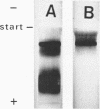Abstract
A peptidase acting on Leu-Gly-Gly and Leu-Tyr at pH 8 to 10 was purified about 670-fold from germinated grains of barley (Hordeum vulgare L.). Gel electrophoretic analyses indicated a purity of about 90%. The purified enzyme is remarkably similar to mammalian leucine aminopeptidases (EC 3.4.1.1) both in chemical and in enzymatic properties. It has a sedimentation constant of 12.7S and a molecular weight of about 260,000. The enzyme has a high activity on leucine amide and di- and tripeptides with N-terminal leucine or methionine; leucyl-β-naphthylamide, in contrast, is hydrolyzed very slowly. The enzyme also liberates N-terminal amino acids from the insulin B chain. The pH optima for the hydrolysis of different substrates depend on the buffers used; highest reaction rates are generally obtained at pH 8.5 to 10.5. Mg2+ and Mn2+ ions stabilize (and probably activate) the enzyme. In contrast to mammalian leucine aminopeptidases, the barley enzyme is inactivated in the absence of reducing sulfydryl compounds.
Full text
PDF





Images in this article
Selected References
These references are in PubMed. This may not be the complete list of references from this article.
- Binkley F., Leibach F., King N. A new method of peptidase assay and the separation of three leucylglycinases of renal tissues. Arch Biochem Biophys. 1968 Nov;128(2):397–405. doi: 10.1016/0003-9861(68)90046-5. [DOI] [PubMed] [Google Scholar]
- DAVIS B. J. DISC ELECTROPHORESIS. II. METHOD AND APPLICATION TO HUMAN SERUM PROTEINS. Ann N Y Acad Sci. 1964 Dec 28;121:404–427. doi: 10.1111/j.1749-6632.1964.tb14213.x. [DOI] [PubMed] [Google Scholar]
- Frohne M., Hanson H. Untersuchungen zur Reaktion der kristallinen Leucinaminopeptidase aus Rinderaugenlinsen mit SH Reagentien. Hoppe Seylers Z Physiol Chem. 1969 Feb;350(2):213–222. [PubMed] [Google Scholar]
- HILL R. L., SMITH E. L. Leucine aminopeptidase. VII. Action on long chain polypeptides and proteins. J Biol Chem. 1957 Oct;228(2):577–600. [PubMed] [Google Scholar]
- Hanson H., Glässer D., Ludewig M., Mannsfeldt H. G., John M. Struktur- und Wirkungsidentität der Leucinaminopeptidase aus Schweinenieren und Rinderaugenlinsen und Vergleich mit der Partikelaminopeptidase aus Schweinenieren. Hoppe Seylers Z Physiol Chem. 1967 Jun;348(6):689–704. [PubMed] [Google Scholar]
- KRETSCHMER K., HANSON H. KRISTALLISIERTE LEUCINAMINOPEPTIDASE AUS RINDERAUGENLINSEN. PHYSIKALISCHE KONSTANTEN, I. Hoppe Seylers Z Physiol Chem. 1965;340:126–137. doi: 10.1515/bchm2.1965.340.1-2.126. [DOI] [PubMed] [Google Scholar]
- Kolehmainen L., Mikola J. Partial purification and enzymatic properties of an aminopeptidase from barley. Arch Biochem Biophys. 1971 Aug;145(2):633–642. doi: 10.1016/s0003-9861(71)80023-1. [DOI] [PubMed] [Google Scholar]
- Margolis J., Kenrick K. G. Polyacrylamide gel electrophoresis in a continuous molecular sieve gradient. Anal Biochem. 1968 Oct 24;25(1):347–362. doi: 10.1016/0003-2697(68)90109-7. [DOI] [PubMed] [Google Scholar]
- Melbye S. W., Carpenter F. H. Leucine aminopeptidase (bovine lens). Stability and size of subunits. J Biol Chem. 1971 Apr 25;246(8):2459–2463. [PubMed] [Google Scholar]
- Melius P., Moseley M. H., Brown D. M. Characterization of the subunits of swine kidney leucine aminopeptidase. Biochim Biophys Acta. 1970 Oct 20;221(1):62–68. doi: 10.1016/0005-2795(70)90197-2. [DOI] [PubMed] [Google Scholar]
- Moeller M., Robbins G. S., Burger W. C., Prentice N. A carboxypeptidase from germinated barley and its action on casein. J Agric Food Chem. 1970 Sep-Oct;18(5):886–890. doi: 10.1021/jf60171a018. [DOI] [PubMed] [Google Scholar]
- SMITH E. L., SPACKMAN D. H. Leucine aminopeptidase. V. Activation, specificity, and mechanism of action. J Biol Chem. 1955 Jan;212(1):271–299. [PubMed] [Google Scholar]
- SPACKMAN D. H., SMITH E. L., BROWN D. M. Leucine aminopeptidase. IV. Isolation and properties of the enzyme from swine kidney. J Biol Chem. 1955 Jan;212(1):255–269. [PubMed] [Google Scholar]
- Visuri K., Mikola J., Enari T. M. Isolation and partial characterization of a carboxypeptidase from barley. Eur J Biochem. 1969 Jan;7(2):193–199. doi: 10.1111/j.1432-1033.1969.tb19591.x. [DOI] [PubMed] [Google Scholar]




